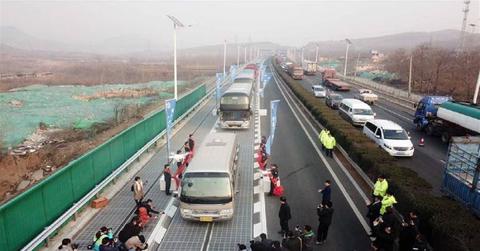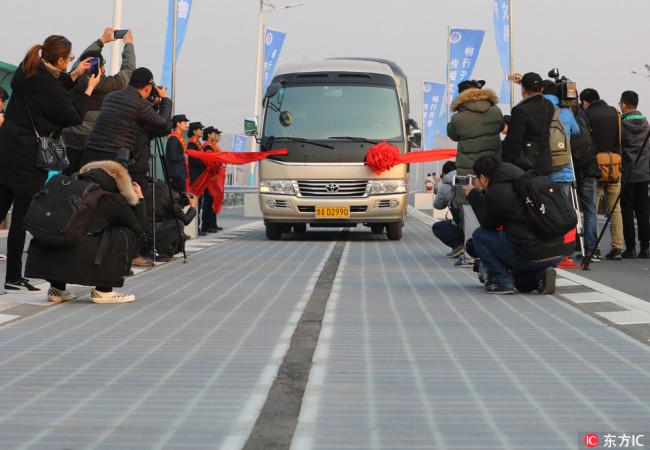China Unveils World's First Solar-Powered Highway
China has officially unveiled a kilometer-long stretch of highway built of transparent concrete and solar panels, which will provide clean electricity, charge electric cars and even melt snow in the winter.
Updated Nov. 19 2020, 9:38 p.m. ET
As solar power becomes increasingly popular, there's one issue standing in the way of its widespread adoption: space. Erecting enough solar panels to effectively offset the use of fossil fuel-based energies requires a lot of sunlit space, and that often gets in the way of other necessary developments—in rural areas, solar farms can displace food farms, and in urban areas, the space is either already taken by buildings or needs to be reserved for more.
Creative solutions to this problem are beginning to pop up, such as solar fields that double as farms for shade-happy agriculture, panels that look like normal roof tiles, floating solar farms that sit atop the ocean or other bodies of water, or, most recently, a solar paneled highway.
Built in Jinan, the capital of China’s Shandong Province, the solar panel highway stretches one kilometer (.62 miles) and contains over 10,000 photovoltaic panels. The panels convert sunlight into electricity just like any other solar panels and functions just like a normal road, if not better—the paneled road is said to have safety standards that surpass that of traditional asphalt highways. The highway can handle 10 times more pressure than a normal asphalt road and will generate 1 million kWH of electricity a year.
The highway is built with transparent concrete with electromagnetic induction coils installed underneath. In addition to collecting sunlight and converting it into electricity, the road also allows electric cars to recharge wirelessly as they drive. Additionally, the energy collected by the panels can be used to warm the road in the winter, thus melting the snow and making it safer to drive.
On top of all that, the panels contain sensors that will collect data on the use of the road, which will help inform the future use of this highway as well as any others that may be installed around the world.
The project in China defies nay-sayers, who have said while using that already-exposed and open space for solar paneling is a good idea, it's impractical in practice—too expensive, not able to collect enough power to make it worthwhile, and ultimately not safe enough (though China's roadway has disproved this last point).
The other points may be true—the road in China cost much more than a normal highway and some say this method collects 20 percent less energy than standard rooftop panels—but for solar-ambitious China, it's worth the cost. China became the world’s top solar-energy producer 2016 by upping its photovoltaic capacity to 78 gigawatts. It’s aiming for 105 by 2020. The Chinese city Huainan also operates the world’s biggest floating solar farm, which will eventually power up to 94,000 homes.
Though China claims this is the "world's first solar highway," France made the same claim with a highway of similar length in 2016. Before that, the Netherlands laid a bike path embedded with solar panels in 2014. No matter who was first, China certainly won't be the last. An American company, Solar Roadways, raised over $2 million to launch a pilot program in Sandpoint, Idaho, which should come to fruition soon.

